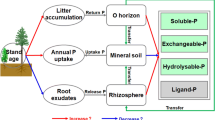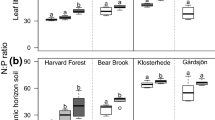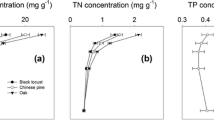Abstract
The impact of extended herbicide (H) and annual fertilizer (F) treatments on the mineral soil carbon (C) pool and nitrogen (N) and phosphorous (P) availability were analyzed in managed loblolly pine (Pinus taeda L.) plantations in the Piedmont of Georgia in stands ranging from 4 to 16 years old. Mineral soil C, N, P, and extractable P were measured in 66 plots in three locations comparing H, F, and their combination HF to the Control plots. Soils were sampled in January 2000 near Eatonton (n = 40), in August 2001 near Athens (n = 12), and in March 2003 near Dawsonville (n = 14). In addition, twelve plots (two H and two HF at each location) were measured on 17 dates using a mixed bead resin core technique to estimate mineral soil N availability. At all three study locations the H treatment tended to deplete the mineral soil C pool while, overall, the F treatments did not determine any significant mineral soil C increase. The soil C pool (0- to 50-cm depth) was depleted by about 5 Mg C ha−1 under the H-treated plots near Eatonton. The HF plots had much higher resin-extractable N than the corresponding H plots in all months of the year. At a plot level, HF values ranged from about 9 to 3,195 μg N g−1 resin while H values ranged from about 4 to 858 μg N g−1 resin. The corresponding annual cumulative resin-extractable N ranged from about 13 kg N ha−1 in the H to about 372 kg N ha−1 in the HF. Extractable P values were also elevated in all F-treated plots. Fertilization and herbicide treatments favored C sequestration only in the aboveground biomass. No significant change was observed in the mineral soil C pool, despite the generally observed increases in soil available N and P.




Similar content being viewed by others
References
Adams MA, Polglase PJ, Attiwill PM, Weston CJ (1989) In situ studies of nitrogen mineralization and uptake in forest soils; some comments on the methodology. Soil Biol Biochem 21:423–429
Albaugh TJ, Allen HL, Dougherty PM, Johnsen KH (2004) Long term growth responses of loblolly pine to optimal nutrient and water resource availability. For Ecol Manage 192:3–19
Amato M, Ladd JN (1992) Decomposition of 14C-labeled glucose and legume material in soils: properties influencing the accumulation of organic residue C and microbial biomass C. Soil Biol Biochem 24:455–464
Aust WM, Lea R (1991) Site temperature and organic matter in a disturbed forested wetland. Soil Sci Soc Am J 55:1741–1746
Binkley D, Hart SC (1989) The components of nitrogen availability assessments in forest soils. Adv Soil Sci 10:57–112
Binkley D, Matson P (1983) Ion exchange resin bag method for assessing forest soil nitrogen availability. Soil Sci Soc Am J 47:1050–1052
Birdsey RA (1992) Carbon storage and accumulation in United States forest ecosystems. General technical report WO-59. United States Department of Agriculture, Forest Service, Washington, DC, USA
Borders BE, Bailey RL (2001) Loblolly pine—pushing the limits of growth. South J App For 25:69–74
Borders BE, Will RE, Markewitz D, Clark A, Hendrick R, Teskey RO, Zhang Y (2004) Effect of complete competition control and annual fertilization on stem growth and canopy relations for a chronosequence of loblolly pine plantations in the lower coastal plain of Georgia. For Ecol Manage 192:21–37
Bremmer JM, Mulvaney CS (1982) Nitrogen—total. In: Page AL, Miller RH, Keeney DR (eds) Methods of soil analysis. Part 2. Chemical and microbiological properties. Soil Science Society of America, Madison, WI, USA, pp 595–624
Butnor JR, Johnsen KH, Sanchez FG (2006) Whole-tree and forest floor removal from a loblolly pine plantation have no effect on forest floor CO2 efflux 10 years after harvest. For Ecol Manage 227:89–95
Carlyle JC (1993) Organic carbon in forested sandy soils: properties, processes, and the impact of forest management. N Z J For Sci 23:390–402
Carpenter SR, Caraco NF, Correll DL, Howarth RW, Sharpley AN, Smith VH (1998) Nonpoint pollution of surface waters with phosphorus and nitrogen. Ecol Applic 8:559–568
Dean AM, Voss DT (1999) Design and analysis of experiments. Springer-Verlag, New York, NY, USA, 740 pp
Echeverria ME, Markewitz D, Morris LA, Hendrick RL (2004) Soil organic matter fractions under managed pine plantations of the southeastern USA. Soil Sci Soc Am J 68:950–958
Fransson A, Bergkvist B (2000) Phosphorus fertilization causes durable enhancement of phosphorus concentrations in forest soil. For Ecol Manage 130:69–76
Garten Jr CT (2002) Soil carbon storage beneath recently established tree plantations in Tennessee and South Carolina, USA. Biomass Bioenergy 23:93–102
Giardina CP, Binkley D, Ryan MG, Fownes JH, Senock RS (2004) Belowground carbon cycling in a humid tropical forest decreases with fertilization. Oecologia 139:545–550
Gough CM, Seiler JR (2004) Belowground carbon dynamics in loblolly pine (Pinus taeda) immediately following diammonium phosphate fertilization. Tree Physiol 24:845–851
Hanselman TA, Graetz DA, Obreza TA (2004) A comparison of in situ methods for measuring net nitrogen mineralization rates of organic soil amendments. J Environ Qual 33:1098–1105
Harrison WM, Borders BE (1996) Yield prediction and growth projection for site-prepared loblolly pine plantations in the Carolinas, Georgia, Alabama and Florida. PMRC technical report 1. University of Georgia Warnell School of Forest Resources, Athens, GA, USA, 64 pp
Harrison KG, Broecker WS, Bonani G (1993) The effect of changing land use on soil radiocarbon. Science 262:725–726
Heath LS, Kimble JM, Birdsey RA, Lal R (2003) Chapter 23. The potential of U.S. forest soils to sequester carbon. In: Kimble JM, Heath LS, Birdsey RA, Lal R (eds) The potential of U.S. forest soils to sequester carbon and mitigate the greenhouse effect. CRS Press, Boca Raton, FL, USA, pp 385–394
Humphreys FR, Pritchett WL (1971) Phosphorus adsorption and movement in some sandy forest soils. Soil Sci Soc Am Proc 35:495–500
Huntington TG (1995) Carbon sequestration in an aggrading forest ecosystem in the southeastern USA. Soil Sci Soc Am J 59:1459–1467
Ingram JSI, Fernandes ECM (2001) Managing carbon sequestration in soils: concepts and terminology. Agr Ecosyst Environ 87:111–117
Janzen HH (2004) Carbon cycling in earth systems—a soil science perspective. Agr Ecosyst Environ 104:399–417
Jenkinson DS (1977) Studies on the decomposition of plant material in soil. V. The effects of plant cover and soil type on the loss of carbon from 14C labeled ryegrass decomposing under field conditions. J Soil Sci 28:424–434
Johnsen KH, Wear D, Oren R, Teskey RO, Sanchez F, Will R, Butnor J, Markewitz D, Richter D, Rials T, Allen HL, Seiler J, Ellsworth D, Maier C, Katul G, Dougherty PM (2001) Meeting global policy commitments: carbon sequestration and southern pine forests. J For 99:14–21
Johnson DW (1995) Role of carbon in the cycling of other nutrients in forested ecosystems. In: McFee WW, Kelly JM (eds) Carbon forms and functions in forest soils. Soil Science Society of America, Madison, WI, USA, pp 299–328
Johnson DW, Curtis PS (2001) Effects of forest management on soil C and N storage: meta analysis. For Ecol Manage 140:227–238
Johnson DW, Hoylman AM, Ball JT, Walker RF (2006) Ponderosa pine responses to elevated CO2 and nitrogen fertilization. Biogeochemistry 77:157–175
Johnson DW, Todd Jr DE, Tolbert VR (2003) Changes in ecosystem carbon and nitrogen in a loblolly pine plantation over the first 18 years. Soil Sci Soc Am J 67:1594–1601
Johnson RA, Wichern DW (1998) Applied multivariate statistical analysis, 4th edn. Prentice Hall, Upper Saddle River, NJ, USA, 816 pp
Jokela EJ, Dougherty PM, Martin TA (2004) Production dynamics of intensively managed loblolly pine stands in the southern United States: a synthesis of seven long-term experiments. For Ecol Manage 192:117–130
Jorgensen JR, Wells CG (1986) Foresters’ primer in nutrient cycling. A loblolly pine management guide.General technical report SE-37. United States Department of Agriculture, Forest Service, Southeastern Forest Experiment Station, Asheville, NC, USA, 42 pp
Keeny DR (1980) Prediction of soil nitrogen availability in forest ecosystems: a literature review. For Sci 26:159–171
Kuchler AW (1964) Potential natural vegetation of the counterminous United States. Special publication 36. American Geographical Society, New York, NY, USA, 116 pp
Kuo S (1996) Phosphorus. In: Sparks DL (ed) Methods of soil analysis. Part 3. Chemical methods. Soil Science Society of America, Madison, WI, USA, pp 869–919
Lal R (2004) Soil carbon sequestration impacts on global climate change and food security. Science 304:1623–1627
Lee JJ, Dodson R (1996) Potential carbon sequestration by afforestation of pasture in the south-central United States. Agron J 88:381–384
Maimone RA, Morris LA, Fox TR (1991) Soil nitrogen mineralization potential in a fertilized loblolly pine plantation. Soil Sci Soc Am J 55:522–527
Markewitz D (2006) Fossil fuel carbon emissions from silviculture: impacts on net carbon sequestration in forests. For Ecol Manage 236:153–161
McNab WH, Avers PE (1994) Ecological subregions of the United States: section descriptions. Administrative Publication WO-WSA-5. United States Department of Agriculture-Forest Service, Washington, DC, USA, 267 pp
Morris LA, Pritchett WL, Swindel BF (1983) Displacement of nutrients into windrows during site preparation of a flatwood forest. Soil Sci Soc Am J 47:591–594
Mulvaney RL (1996) Nitrogen–inorganic forms. In: Sparks DL (ed) Methods of soil analysis. Part 3. Chemical methods. Soil Science Society of America, Madison, WI, USA, pp 1123–1184
Munson AD, Margolis HA, Brand DG (1993) Intensive silvicultural treatment: impacts on soil fertility and planted conifer response. Soil Sci Soc Am J 57:246–255
Nelson DW, Sommers LE (1996) Total carbon, organic carbon, and organic matter. In: Sparks DL (ed) Methods of soil analysis. Part 3. Chemical methods. Soil Science Society of America, Madison, WI, USA, pp 961–1010
Nicholson G (1984) Methods of soil, plant, and water analysis. Forest Research Institute Bulletin 70. New Zealand Forest Service, New Zealand
Niu X, Duiker SW (2006) Carbon sequestration potential by afforestation of marginal agricultural land in the Midwestern U.S. For Ecol Manage 223:415–427
Oades JM, Waters AG (1991) Aggregate hierarchy in soils. Aust J Soil Res 29:815–828
Paul KI, Polglase PJ, Nyakuengama JG, Khanna PK (2002) Change in soil carbon following afforestation. For Ecol Manage 168:241–257
Paustian K, Six J, Elliott ET, Hunt HW (2000) Management options for reducing CO2 emissions from agricultural soils. Biogeochemistry 48:147–163
Piatek KB, Allen HL (2001) Are forest floors in mid-rotation stands of loblolly pine (Pinus taeda) a sink for nitrogen and phosphorus? Can J For Res 31:1164–1174
Polglase PJ, Comerford NB, Jokela EJ (1992) Mineralization of nitrogen and phosphorus from soil organic matter in southern pine plantations. Soil Sci Soc Am J 56:921–927
Post WM, Kwon KC (2000) Soil carbon sequestration and land-use change: processes and potential. Glob Change Biol 6:317–327
Richter DD, Allen HL, Li J, Markewitz D, Raikes J (2006) Bioavailability of slowly cycling soil phosphorus: major restructuring of soil P fractions over four decades in an aggrading forest. Oecologia 150:259–271
Richter DD, Markewitz D, Dunsomb JK, Heine PR, Wells CG, Stuanes A, Allen HL, Urrego B, Harrison K, Bonani G (1995) Carbon cycling in a loblolly pine forest: implications for the missing carbon sink and for the concept of soil. In: McFee WW, Kelly JM (eds) Carbon forms and functions in forest soils. Soil Science Society of America, Madison, WI, USA, pp 233–252
Sanchez FG, Eaton RJ (2001) Sequestering carbon and improving soils: benefits of mulching and incorporating forest slash. J Forest 99:32–36
Sartori F (2004) Soil-site productivity indices and tree growth in loblolly pine (Pinus taeda L.) plantations. Ph.D. Dissertation. University of Georgia, Athens, GA, USA
Sartori F, Lal R, Ebinger ME, Parrish DJ (2006) Potential soil carbon sequestration and CO2 offset by dedicated energy crops in the USA. Crit Rev Plant Sci 25:441–472
SAS Institute (1990) SAS/STAT User’s Guide, Version 6, 4th edn. SAS Institute, Cary, NC, USA
Schlesinger WH, Lichter J (2001) Limited carbon storage in soil and litter of experimental forest plots under increased atmospheric CO2. Nature 411:466–469
Shan J, Morris LA, Hendrick RL (2001) The effects of management on soil and plant carbon sequestration in slash pine plantations. J Appl Ecol 38:932–941
Six J, Callewaert P, Lenders S, De Gryze S, Morris SJ, Gregorich EG, Paul EA, Paustian K (2002) Measuring and understanding carbon storage in afforested soils by physical fractionation. Soil Sci Soc Am J 66:1981–1987
Tisdall JM, Oades JM (1982) Organic matter and water-stable aggregates in soils. J Soil Sci 33:141–163
USDA-SCS (United States Department of Agriculture-Soil Conservation Service) (1968) Soil survey of Clarke-Oconee counties, Georgia. United States Department of Agriculture, Washington, DC, USA
USDA-SCS (United States Department of Agriculture-Soil Conservation Service) (1972) Soil survey of Dawson, Lumpkin, and White Counties, Georgia. United States Department of Agriculture, Washington, DC, USA
Van Lear DH, Kapeluck PR, Parker MM (1995) Distribution of carbon in a piedmont soil as affected by loblolly pine management. In: McFee WW, Kelly JM (eds) Carbon forms and functions in forest soils. Soil Science Society of America, Madison, WI, USA, pp 489–501
Vitousek PM, Andariese SW, Matson PA, Morris L, Sanford RL (1992) Effects of harvest intensity, site preparation, and herbicide use on soil nitrogen transformations in a young loblolly pine plantation. For Ecol Manage 49:277–292
Vitousek PM, Matson PA (1984) Mechanisms of nitrogen retention in forest ecosystems: a field experiment. Science 225:51–52
Vitousek PM, Matson PA (1985) Disturbance, nitrogen availability, and nitrogen losses in an intensively managed loblolly pine plantation. Ecology 66:1360–1376
Vose JM, Allen HL (1988) Leaf area, stemwood growth, and nutrition relationships in loblolly pine. For Sci 34:547–563
Will RE, Markewitz D, Hendrick RL, Meason DF, Crocker TR, Borders BE 2006 Nitrogen and phosphorus dynamics for 13-year-old loblolly pine stands receiving complete competition control and annual N fertilizer. For Ecol Manage 227:155–168
Wright RB, Lockaby BG, Walbridge MR (2001) Phosphorus availability in an artificially flooded southeastern floodplain forest soil. Soil Sci Soc Am J 65:1293–1302
Acknowledgements
The authors thank Daniel Hall, Miguel Cabrera, Larry Morris, and two anonymous reviewers for their suggestions and revisions. We also thank Jay Brown, Patrick Bussel, Mike Marsh, and Norma Rainwater for assistance during field and laboratory work. We would like to express our gratitude to the University of Georgia, D.B. Warnell School of Forestry and Natural Resources and the Consortium for Pine Productivity Studies (CAPPS) for providing their study data.
Author information
Authors and Affiliations
Corresponding author
Rights and permissions
About this article
Cite this article
Sartori, F., Markewitz, D. & Borders, B.E. Soil carbon storage and nitrogen and phosphorous availability in loblolly pine plantations over 4 to16 years of herbicide and fertilizer treatments. Biogeochemistry 84, 13–30 (2007). https://doi.org/10.1007/s10533-007-9072-8
Received:
Accepted:
Published:
Issue Date:
DOI: https://doi.org/10.1007/s10533-007-9072-8




